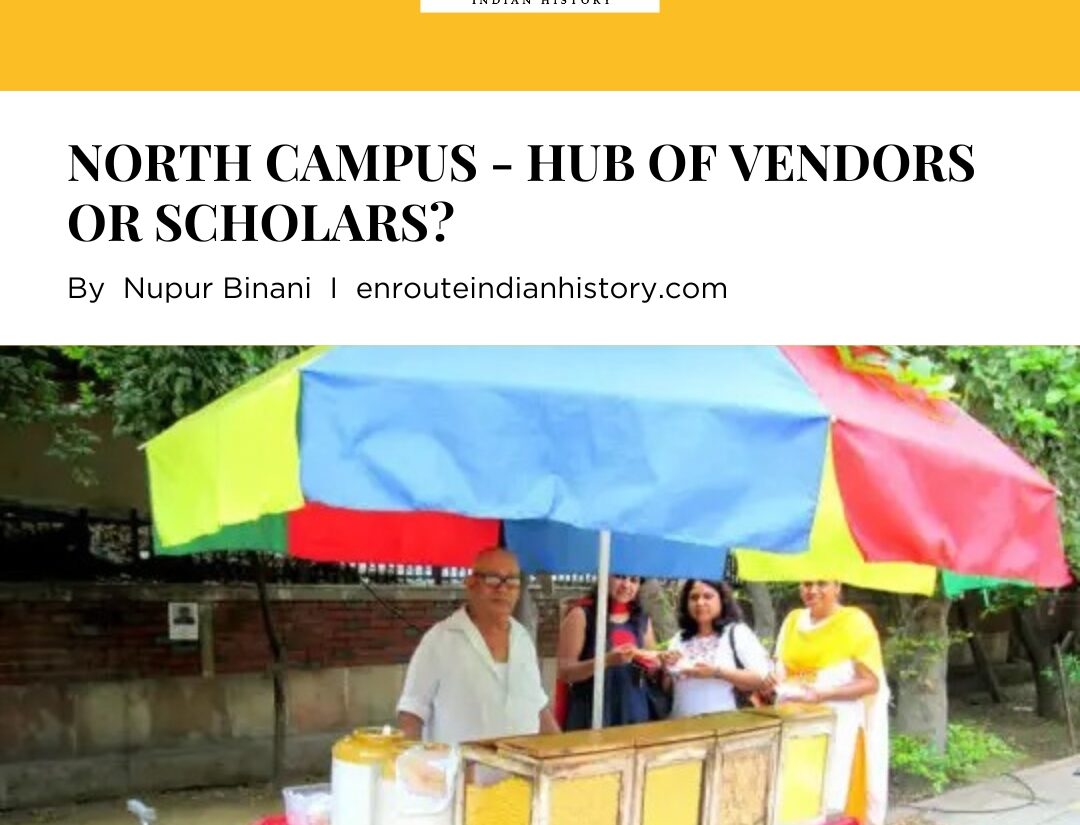
“Kamla Nagar, Kamla Nagar! Miranda, Miranda! Hindu, Hindu!” Drivers of shared auto-rickshaws call out to commuters emerging from the Vishwavidyalaya Metro Station, in just mere 20 rupees they will take you to the dream college of many students out there- The North Campus of Delhi University, located in the heart of Capital City illustrating a blend of academic excellence, synthesis of different cultures, and creativity in urban milieu is the most hyped place among students. The place is known not only for its top colleges but also for their creative vendors, but why creative? Well, as we will unfold upcoming chapters the word “creative” will be an underestimation of those vendors. Before proving my confidence, I would like to introduce myself. I am Nupur, a regular student of Delhi University but my real motivation to attend college is not the classes but indeed food near campus which do make me an justified writer talking about Vendors of North campus.

The University enclave spreaded over several square kilometers is a cluster of affiliated colleges of University of Delhi. Colleges like Shri ram college of commerce, St Stephens, Hindu, Hansraj, Kirorimal, Miranda, Ramjas, Daulat ram, Khalsa, Fms, Delhi school of economics, faculty of arts are the roots of this area. One can witness a mix of cultures interacting and forming a new lifestyle with the essence of freedom, students from all over the country form their home in the new city. Imagine a high school graduate entering an unknown city for a new life, what will be the basic requirement for survival? Shelter? Food? Friends? Undoubtedly, North campus has an answer for all. From Kamla Nagar, Shakti Nagar, Malkaganj, Chandrawal, Vijayanagar, Guru teg bahadur marg to Mukherjee Nagar the lanes of Campus are filled with Pgs, Flats and Hostels providing various options for students to find an apt place and the college will provide enough acquaintances, friends or maybe a family but the “food” will unite those students. More than colleges and libraries, you will see vendors at every step which does make it a hub of vendors! It would be wrong if I say they are mere a “thela wala bhaiya” while they are the real testimony of change, the subjects of oral history, the emotional connect of students and indeed the best place for political discussion. Today, these vendors are landmark; let it be Patel chest wali bhel puri, Kmc backgate’s sev puri, Chole Bhature of Kamla, Hansraj wale Vada pav or Laphing in Kamla, people come from far away places just to enjoy that one bite.
Before indulging our taste buds into delicious chapters, we need to walk down on its history. Food, Culture & Society An International Journal of Multidisciplinary Research talks about the streets of Batra market and Campus area.
The lanes which have new vendors every next day were once restricted from such vendors; Sunil Sethi, a veteran vendor on the main campus thoroughfare explains why street food is so strictly regulated in the university. Expertly ladling out heaped plates of bhelpuri to waiting students as cars and rickshaws stream past, he says,

“Dekho, behenji, yeh sensitive maamla hai. Student politics par nigraani rakhte hain. Sadak ko clear rakhte hain. Phir prestige ki bhi baat hai. Yahaan koi naya thela aaye to VC office seedhe thaane ko phone karte hai.”

Sethi reminds me that, during the Commonwealth Games in 2010 when the university sports ground was used for rugby matches, he was not even allowed to set up his cart for a month. During an event where “the whole world was watching,” the authorities perceived the presence of a cart as a blemish on the sanitized streets of the campus and on the “world-class” image of the city that it sought to create (Baviskar 2011). This aesthetic is coupled with a concern for security. The campus has an active student political life. Elections to the students’ union are keenly contested by “youth wings” affiliated with major Indian political parties.
Ironically, neither the vendors of Batra Market, GTB nor of Campus were allowed to set their stalls, they were often removed by mcd. Based on the principles of protection and regulation, the provisions of the Street Vendors Act 2014 incorporate more fully the rights of those earning their livelihood in public spaces. The Act calls for the setting up of local Town Vending Committees (TVCs), chaired by the Municipal Commissioner, with at least 40% representation for elected street vendors. The TVC is charged with carrying out surveys of vendors every five years, issuing identity cards and “certificates of vending” which would function as licenses. Such forms of state recognition would give vendors relief from the everyday bullying and bribe-taking of police and municipal officials. On paper, the Act is a progressive piece of legislation that protects vendors’ rights but its practice has proved to be contentious and cumbersome. As directed by the law, the state government of Delhi formulated rules and procedures for implementing the Act in January 2016, compiled in a document called the Delhi Food, Culture and Society . However, the Act specifies that such rules must be drawn up in consultation with the TVCs to ensure that vendors are not left out of decision-making. The rules shifted the balance of power back to the city’s propertied classes by giving shop-owners’ associations and Resident Welfare Associations the right to veto the demarcation of vending zones. Startlingly, it also prohibited cooking and selling food on streets around places of worship, educational institutions, hospitals or railway stations – precisely those places where potential customers congregate in greatest numbers and where inexpensive fresh food is most in demand. Moreover, vending time was restricted from sunrise to sunset, the evening curfew cutting short lucrative dinnertime hours. Clearly, the government was doing its best to neutralize the provender thrust of the legislation, emphasizing regulation at the expense of protection. While the Act has not yet delivered on its promise, it has stayed the hands of police and municipal officials to some extent. Raids and evictions have become infrequent since 2014. Indeed, more migrants have taken advantage of the stalemate to join the ranks of vendors already on the streets, the Act has allowed street food vendors to proliferate but it hasn’t enabled access to clean municipal tap water or encouraged waste reduction and recycling. While municipal authorities prefer a punitive approach to the issue of food hygiene, other government agencies have been more sympathetic to the predicament of food vendors. In 2018, the Food Safety and Standards Authority of India (FSSAI), an autonomous body under the Ministry of Health, partnered with NASVI to start a training program in Delhi for 23,000 vendors in 40 locations. Those who complete the training get FSSAI certification that they can display on their carts. However, the head of FSSAI Pawan Kumar Aggarwal acknowledged that their efforts were limited: “Our learning was that to bring in sustainable change and improvement in street food hygiene, we have to go beyond just training individuals and providing them with gloves and aprons, etc. We have to also work with different authorities to give better street lighting, drainage, garbage removal and safe water to the vendors” (quoted in Duttagupta 2018). The failure of municipal agencies to provide infrastructure essential for food safety is the chief reason why street food has a bad reputation among middle-class consumers. Yet many still crave its tangy, spicy mix of flavors and the mouthfeel of a jazz combo of textures.

This craving brings us back on our guide path of Campus’s Street food, not just us but also the students exiting their college gate meets at the Tea stall, the campus is filled with Chaiwala bhaiya to name a few are Vishnu Tea stall, Law faculty; Pandit ji ki Chai, Arts Faculty, JP tea stall, DSE; and among them is the rockstar- Sudama Chai wala whose addition of rose petals while preparing chai seems as cherry on the cake. Everyone has their own stories to share. Often the place gets very crowded when students form a huddle and talk for hours at length. From assignments, classes and politics to heartbreaks, we get to hear conversations of all kinds. Often these chai wala serves various namkeen, maggi, Cream Rolls and biscuits attracting even non tea lovers to have a sip.

As you take a stroll from Vishwavidhyala station, your first step should be at Patel chest’s bhelpuri; everyone’s favorite Sunil Sehti is the most friendly and cheerful vendor. The bhel is made of puffed rice,crumbled crunchy puris, onions and tomatoes with green and red chutney serves to be tangy, spicy and sweet which melts in mouth as you continue talking to bhaiya, his replies will help you to tolerate the spiciness bhel holds serving to be one of most preferred evening snacks among students.
Another famous chaat is Sev Puri which you will have at Metro Station and near Kirori Mal college serving their special drink “Banta”- A lemon soda drink. The crunchy puris have a layer of potatoes and a spread of Chutneys, the spicyness is a perfect match with cold Soda drink, indeed a go to place during summers. The vendors are always ready to have conversations about how they came into this profession, the problems they face and how they have made connections with regular students.

Exploring street foods, how can we forget the most hyped snacks amongst kids, teens, adults and even elders- Maggi, often rejected by Indian mothers but Tom uncle Maggi point near Miranda house started by Ramesh Kumar or Titu Bhai in 1990s serves over more than 50 varieties of Maggi with their mocktails and shakes. The place is often filled with students who are always eager to enjoy their new varieties, evenings are often Tom uncle’s junction point.
The blend of cultures led to establishment of Vada pav points in campus, Jhakass being the most popular among them near Hansraj College’s hostel gate serves one of the best Vada pav of Mumbai. The authenticity of pav, the vada and most importantly the red powder attracts people from far away places to have it. Its prime location has led to its hype!
Delhi is famous for its markets like Sarojini, Janpath, Rajouri; one of its markets is adjacent to campus. As you exit either from kirori mal’s backgate or Hansraj hostel gate you enter Kamla Market which is famous not only for shopping but also for the variety of foods it offers. From branded outlets of Mcdonals, Burger king, Theos to Chaat at every corner it offers you a delicious experience. The vendors have their stalls ready with crispy tikkis, waterballs, dahiballas offering you to customize in your way. Some of the famous joints are Vaishnav Chat Bhandar, Manahor in Malka Ganj and stalls near Sparx Mall.
Some Extra love, Extra spice and correct amount of lime juice serves best chaats of delhi in north campus.
Vendors of North campus
Delhi University has completed their legacy of 100 years, over the period of time not only the curriculum and faculty changed but the vendors also opted modern western trends to serve upcoming students. Today we can see varieties of Momos stalls set up all over campus area enjoyed as evening snacks by major Delhi students. The new trend of Korean and Tibtean dishes is very well opted and executed by the “Creative” vendors by setting stalls of Laphing- spicy cold plain flour noodle garnished with tsulasi (chili oil), soy sauce, vinegar and soya chunks. This creativity not only shows a blend of Indian cultures but also the emergence of foreign cultures.
Being a regular student of North Campus, I often visit newly opened cafes in campus but do I get the same taste? Absolutely not, higher prices and lesser quality degrades the image of Delhi chaat. The vendors of Campus not only serve food but give mother’s touch to their dishes, they are the real testimony of society’s evolution, evident subjects for Oral History – what books failed to convey, the vendors continue to remember, they are a way to embrace and continue the traditions. These creative vendors are the heart and soul of North campus, social media reels have made them sensation all over the country, famous alumni from reputed colleges remembers their college life by not what classes taught them but while from that one conversation with “thela wala bhaiya” hence stating it a vendors hub isn’t wrong. Vendors of North campus
The campus known for its academic excellence can never fade its title of scholar’s hub but at the same time the place offering India’s richest vendors need to have an additional title of Vendor’ Hub.

References -:
- Amita Baviskar.Street food and the art of survival: migrants and places in Delhi, India.Food,Culture and Society.
- www.hindustantimes.com. Delhi,hangout-addas-in-north-campus.
















